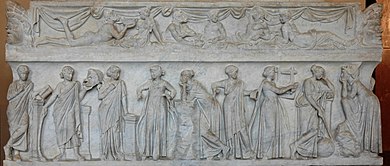 |
| The Nine Muses including Terpsichore on a Roman Sarcophagus
Source Wikipedia
|
When I was young which was not all that long ago nearly everybody who was likely to appreciate ballet would have studied at least a little Latin and probably some Greek. They would have known who Τερψιχόρη was or, at the very least, how to pronounce her name correctly. Sadly that is not the case today for I am often introduced or referred to as Terpsi-core. For future reference there is a useful pronunciation guide (albeit with an American accent) on YouTube.
I don't know whose fault it is but I suspect Lady Williams who did away with grammar schools. If not her then maybe one of Lady Thatcher's Education Secretaries who sacrificed the classics in pursuit of the chimera of relevance. If that was indeed the aim then it was sadly misconceived for nothing has prepared me more for life than the classics. Not only have they helped me understand and express myself in my own tongue but they have helped me learn also other natural languages including those not derived from Latin such as Japanese. They also helped me to learn programming because computers are (or at least were) very unforgiving just like my masters at St. Paul's. I suspect the abandonment of Latin has much to do with the decline in our children's ability to code and the rise of UKIP.
Anyway I digress, Terpsichore was one of nine muses who personified the arts and literature. They were the daughters of Zeus, the ruler of the gods. Terpsichore was the muse of dance and she carried a lyre. The others in alphabetical order were Calliope, muse of poetry, Clio (history), Erato (lyric poetry), Euterpe (song and elegiac poetry), Melpomene (tragedy), Polyhymnia (sacred music), Thalia (comedy) and Urania (astronomy). You will see them all lined up in the frieze above which I think is in the Louvre. I believe Terpsichore is third from the the right. There are more images of Terpsichore on the Warburg Institute website.
As the muse of dance Terpsichore has been the subject of many ballets including one by Marius Petipa to the music of Cesare Pugni. She also appears in Balanchine's Apollo which was revived recently by the Royal Ballet. There are many dance schools around the world that call themselves Terpsichore. There is lots of other references to her in film, drama and literature and I have even found a page for Terpsichore on Facebook.
Post Script
Here is another post on the continuing relevance of the classics. Interestingly it appeared on the Old Paulines Alumni Linkedin Group of which I am also a member. Probably the only female member.


No comments:
Post a Comment